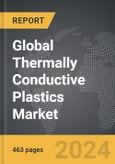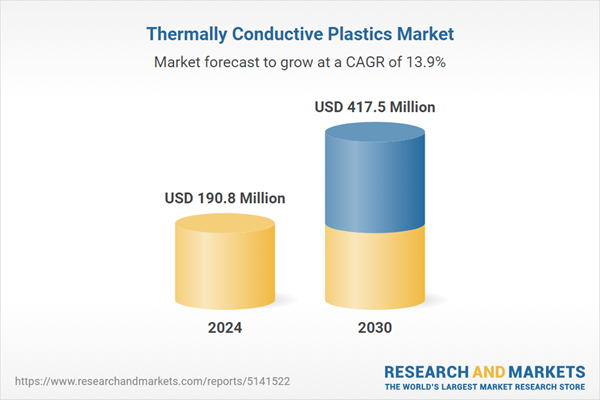The global market for Thermally Conductive Plastics was valued at US$190.8 Million in 2024 and is projected to reach US$417.5 Million by 2030, growing at a CAGR of 13.9% from 2024 to 2030. This comprehensive report provides an in-depth analysis of market trends, drivers, and forecasts, helping you make informed business decisions. The report includes the most recent global tariff developments and what they mean for your business.
The formulation of thermally conductive plastics involves the incorporation of conductive fillers such as graphite, carbon fibers, and metal particles into the polymer matrix. Advances in material science have led to the creation of composites with improved thermal properties without compromising mechanical strength and processability. These materials can be molded into complex shapes and are compatible with standard manufacturing processes, such as injection molding and extrusion. The use of thermally conductive plastics offers several advantages, including reduced weight, corrosion resistance, and cost-effective production, compared to traditional metal-based thermal management solutions.
The growth in the thermally conductive plastics market is driven by several factors. Firstly, the increasing demand for effective thermal management in electronic devices and automotive components is a significant driver. Secondly, advancements in material science and the development of new conductive fillers are enhancing the thermal and mechanical properties of these plastics. Thirdly, the miniaturization of electronic devices and the trend towards lightweight materials in automotive and industrial applications are boosting the adoption of thermally conductive plastics. Additionally, the need for cost-effective and scalable thermal management solutions is driving the market growth. Furthermore, the rising focus on sustainability and the preference for materials that reduce environmental impact are promoting the use of thermally conductive plastics. Lastly, the expansion of industries such as consumer electronics, electric vehicles, and telecommunications is creating new opportunities for the application of thermally conductive plastics.
Segments: Resin Type (Polyamide, Polybutylene Terephthalate (PBT), Polycarbonate (PC), Polyphenylene Sulfide (PPS), Polyetherimide, Other Resin Types); End-Use (Electrical & Electronics, Automotive, Industrial, Healthcare, Aerospace, Other End-Use Uses).
Geographic Regions/Countries: World; USA; Canada; Japan; China; Europe; France; Germany; Italy; UK; Spain; Russia; Rest of Europe; Asia-Pacific; Australia; India; South Korea; Rest of Asia-Pacific; Latin America; Argentina; Brazil; Mexico; Rest of Latin America; Middle East; Iran; Israel; Saudi Arabia; UAE; Rest of Middle East; Africa.
The analysts continuously track trade developments worldwide, drawing insights from leading global economists and over 200 industry and policy institutions, including think tanks, trade organizations, and national economic advisory bodies. This intelligence is integrated into forecasting models to provide timely, data-driven analysis of emerging risks and opportunities.
Global Thermally Conductive Plastics Market - Key Trends & Drivers Summarized
Thermally conductive plastics are advanced polymer materials designed to conduct heat more efficiently than conventional plastics. These materials combine the lightweight and versatile properties of plastics with enhanced thermal conductivity, making them suitable for applications in electronics, automotive, and industrial sectors. Thermally conductive plastics are used in components such as heat sinks, housings, enclosures, and connectors, where effective heat dissipation is crucial for performance and reliability. The development of these materials addresses the growing need for thermal management solutions in compact and high-power devices. Resins used for thermally conductive plastics are polyamide, polybutylene terephthalate, polycarbonate, polyphenylene sulfide, polyetherimide, and other resin types.The formulation of thermally conductive plastics involves the incorporation of conductive fillers such as graphite, carbon fibers, and metal particles into the polymer matrix. Advances in material science have led to the creation of composites with improved thermal properties without compromising mechanical strength and processability. These materials can be molded into complex shapes and are compatible with standard manufacturing processes, such as injection molding and extrusion. The use of thermally conductive plastics offers several advantages, including reduced weight, corrosion resistance, and cost-effective production, compared to traditional metal-based thermal management solutions.
The growth in the thermally conductive plastics market is driven by several factors. Firstly, the increasing demand for effective thermal management in electronic devices and automotive components is a significant driver. Secondly, advancements in material science and the development of new conductive fillers are enhancing the thermal and mechanical properties of these plastics. Thirdly, the miniaturization of electronic devices and the trend towards lightweight materials in automotive and industrial applications are boosting the adoption of thermally conductive plastics. Additionally, the need for cost-effective and scalable thermal management solutions is driving the market growth. Furthermore, the rising focus on sustainability and the preference for materials that reduce environmental impact are promoting the use of thermally conductive plastics. Lastly, the expansion of industries such as consumer electronics, electric vehicles, and telecommunications is creating new opportunities for the application of thermally conductive plastics.
Report Scope
The report analyzes the Thermally Conductive Plastics market, presented in terms of units. The analysis covers the key segments and geographic regions outlined below.Segments: Resin Type (Polyamide, Polybutylene Terephthalate (PBT), Polycarbonate (PC), Polyphenylene Sulfide (PPS), Polyetherimide, Other Resin Types); End-Use (Electrical & Electronics, Automotive, Industrial, Healthcare, Aerospace, Other End-Use Uses).
Geographic Regions/Countries: World; USA; Canada; Japan; China; Europe; France; Germany; Italy; UK; Spain; Russia; Rest of Europe; Asia-Pacific; Australia; India; South Korea; Rest of Asia-Pacific; Latin America; Argentina; Brazil; Mexico; Rest of Latin America; Middle East; Iran; Israel; Saudi Arabia; UAE; Rest of Middle East; Africa.
Key Insights:
- Market Growth: Understand the significant growth trajectory of the Polyamide segment, which is expected to reach US$109.9 Million by 2030 with a CAGR of a 14.2%. The Polybutylene Terephthalate (PBT) segment is also set to grow at 14.7% CAGR over the analysis period.
- Regional Analysis: Gain insights into the U.S. market, valued at $60.0 Million in 2024, and China, forecasted to grow at an impressive 17.2% CAGR to reach $69.3 Million by 2030. Discover growth trends in other key regions, including Japan, Canada, Germany, and the Asia-Pacific.
Why You Should Buy This Report:
- Detailed Market Analysis: Access a thorough analysis of the Global Thermally Conductive Plastics Market, covering all major geographic regions and market segments.
- Competitive Insights: Get an overview of the competitive landscape, including the market presence of major players across different geographies.
- Future Trends and Drivers: Understand the key trends and drivers shaping the future of the Global Thermally Conductive Plastics Market.
- Actionable Insights: Benefit from actionable insights that can help you identify new revenue opportunities and make strategic business decisions.
Key Questions Answered:
- How is the Global Thermally Conductive Plastics Market expected to evolve by 2030?
- What are the main drivers and restraints affecting the market?
- Which market segments will grow the most over the forecast period?
- How will market shares for different regions and segments change by 2030?
- Who are the leading players in the market, and what are their prospects?
Report Features:
- Comprehensive Market Data: Independent analysis of annual sales and market forecasts in US$ Million from 2024 to 2030.
- In-Depth Regional Analysis: Detailed insights into key markets, including the U.S., China, Japan, Canada, Europe, Asia-Pacific, Latin America, Middle East, and Africa.
- Company Profiles: Coverage of players such as Arkema Group, Avient Corporation, BASF SE, Celanese Corporation, Covestro AG and more.
- Complimentary Updates: Receive free report updates for one year to keep you informed of the latest market developments.
Some of the 73 companies featured in this Thermally Conductive Plastics market report include:
- Arkema Group
- Avient Corporation
- BASF SE
- Celanese Corporation
- Covestro AG
- DuPont de Nemours, Inc
- Ensinger Gmbh
- Exxon Mobil Corporation
- HELLA GmbH & Co. KGaA
- Imerys S.A.
- Kaneka Corporation
- Kenner Material & System Co. Ltd
- Lanxess AG
- Lehmann & Voss & Co.
- Lotte Chemical Corporation
- Mitsubishi Engineering-Plastics Corp.
- Nytex Composite Co., Ltd
- Ovation Polymers Inc.
- Royal DSM N.V.
- RTP Company
- Saint-Gobain Group
- Saudi Basic Industries Corporation (SABIC)
- Themix Specialty Products LLC
- Toray Industries, Inc.
- Ugent Tech Sdn Bhd.
Tariff Impact Analysis: Key Insights for 2025
Global tariff negotiations across 180+ countries are reshaping supply chains, costs, and competitiveness. This report reflects the latest developments as of April 2025 and incorporates forward-looking insights into the market outlook.The analysts continuously track trade developments worldwide, drawing insights from leading global economists and over 200 industry and policy institutions, including think tanks, trade organizations, and national economic advisory bodies. This intelligence is integrated into forecasting models to provide timely, data-driven analysis of emerging risks and opportunities.
What’s Included in This Edition:
- Tariff-adjusted market forecasts by region and segment
- Analysis of cost and supply chain implications by sourcing and trade exposure
- Strategic insights into geographic shifts
Buyers receive a free July 2025 update with:
- Finalized tariff impacts and new trade agreement effects
- Updated projections reflecting global sourcing and cost shifts
- Expanded country-specific coverage across the industry
Table of Contents
I. METHODOLOGYMII. EXECUTIVE SUMMARY2. FOCUS ON SELECT PLAYERSIII. MARKET ANALYSISCANADAITALYSPAINRUSSIAREST OF EUROPESOUTH KOREATAIWANREST OF ASIA-PACIFICARGENTINABRAZILMEXICOREST OF LATIN AMERICAIV. COMPETITION
1. MARKET OVERVIEW
3. MARKET TRENDS & DRIVERS
4. GLOBAL MARKET PERSPECTIVE
UNITED STATES
JAPAN
CHINA
EUROPE
FRANCE
GERMANY
UNITED KINGDOM
ASIA-PACIFIC
AUSTRALIA
INDIA
LATIN AMERICA
MIDDLE EAST
AFRICA
Companies Mentioned (Partial List)
A selection of companies mentioned in this report includes, but is not limited to:
- Arkema Group
- Avient Corporation
- BASF SE
- Celanese Corporation
- Covestro AG
- DuPont de Nemours, Inc
- Ensinger Gmbh
- Exxon Mobil Corporation
- HELLA GmbH & Co. KGaA
- Imerys S.A.
- Kaneka Corporation
- Kenner Material & System Co. Ltd
- Lanxess AG
- Lehmann & Voss & Co.
- Lotte Chemical Corporation
- Mitsubishi Engineering-Plastics Corp.
- Nytex Composite Co., Ltd
- Ovation Polymers Inc.
- Royal DSM N.V.
- RTP Company
- Saint-Gobain Group
- Saudi Basic Industries Corporation (SABIC)
- Themix Specialty Products LLC
- Toray Industries, Inc.
- Ugent Tech Sdn Bhd.
Table Information
| Report Attribute | Details |
|---|---|
| No. of Pages | 463 |
| Published | April 2025 |
| Forecast Period | 2024 - 2030 |
| Estimated Market Value ( USD | $ 190.8 Million |
| Forecasted Market Value ( USD | $ 417.5 Million |
| Compound Annual Growth Rate | 13.9% |
| Regions Covered | Global |









